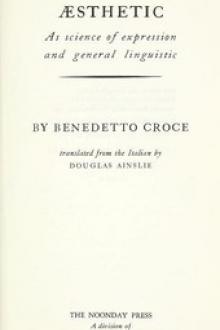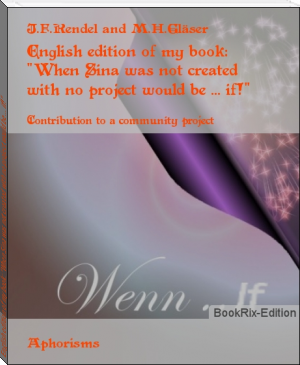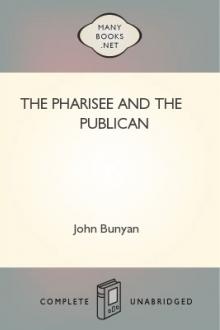The Sense of Beauty by George Santayana (ebooks children's books free .TXT) 📖

- Author: George Santayana
- Performer: -
Book online «The Sense of Beauty by George Santayana (ebooks children's books free .TXT) 📖». Author George Santayana
Nothing is objectively impressive; things are impressive only when they succeed in touching the sensibility of the observer, by finding the avenues to his brain and heart. The idea that the universe is a multitude of minute spheres circling, like specks of dust, in a dark and boundless void, might leave us cold and indifferent, if not bored and depressed, were it not that we identify this hypothetical scheme with the visible splendour, the poignant intensity, and the baffling number of the stars. So far is the object from giving value to the impression, that it is here, as it must always ultimately be, the impression that gives value to the object. For all worth leads us back to actual feeling somewhere, or else evaporates into nothing — into a word and a superstition.
Now, the starry heavens are very happily designed to intensify the sensations on which their beauties must rest. In the first place, the continuum of space is broken into points, numerous enough to give the utmost idea of multiplicity and yet so distinct and vivid that it is impossible not to remain aware of their individuality. The variety of local signs, without becoming organized into forms, remains prominent and irreducible. This makes the object infinitely more exciting than a plane surface would be. In the second place, the sensuous contrast of the dark background, — blacker the clearer the night and the more stars we can see, — with the palpitating fire of the stars themselves, could not be exceeded by any possible device. This material beauty adds incalculably, as we have already pointed out, to the inwardness and sublimity of the effect. To realize the great importance of these two elements, we need but to conceive their absence, and observe the change in the dignity of the result.
Fancy a map of the heavens and every star plotted upon it, even those invisible to the naked eye: why would this object, as full of scientific suggestion surely as the reality, leave us so comparatively cold? Quite indifferent it might not leave us, for I have myself watched stellar photographs with almost inexhaustible wonder. The sense of multiplicity is naturally in no way diminished by the representation; but the poignancy of the sensation, the life of the light, are gone; and with the dulled impression the keenness of the emotion disappears. Or imagine the stars, undiminished in number, without losing any of their astronomical significance and divine immutability, marshalled in geometrical patterns; say in a Latin cross, with the words In hoc signo vinces in a scroll around them. The beauty of the illumination would be perhaps increased, and its import, practical, religious, and cosmic, would surely be a little plainer; but where would be the sublimity of the spectacle? Irretrievably lost: and lost because the form of the object would no longer tantalize us with its sheer multiplicity, and with the consequent overpowering sense of suspense and awe.
In a word, the infinity which moves us is the sense of multiplicity in uniformity. Accordingly things which have enough multiplicity, as the lights of a city seen across water, have an effect similar to that of the stars, if less intense; whereas a star, if alone, because the multiplicity is lacking, makes a wholly different impression. The single star is tender, beautiful, and mild; we can compare it to the humblest and sweetest of things:
A violet by a mossy stone
Half hidden from the eye,
Fair as a star when only one
Is shining in the sky.
It is, not only in fact but in nature, an attendant on the moon, associated with the moon, if we may be so prosaic here, not only by contiguity but also by similarity.
Fairer than Phoebe's sapphire-regioned star
Or vesper, amorous glow-worm of the sky.
The same poet can say elsewhere of a passionate lover:
He arose
Ethereal, flushed, and like a throbbing star,
Amid the sapphire heaven's deep repose.
How opposite is all this from the cold glitter, the cruel and mysterious sublimity of the stars when they are many! With these we have no Sapphic associations; they make us think rather of Kant who could hit on nothing else to compare with his categorical imperative, perhaps because he found in both the same baffling incomprehensibility and the same fierce actuality. Such ultimate feelings are sensations of physical tension.
Defects of pure multiplicity.
§ 26. This long analysis will be a sufficient illustration of the power of multiplicity in uniformity; we may now proceed to point out the limitations inherent in this form. The most obvious one is that of monotony; a file of soldiers or an iron railing is impressive in its way, but cannot long entertain us, nor hold us with that depth of developing interest, with which we might study a crowd or a forest of trees.
The tendency of monotony is double, and in two directions deadens our pleasure. When the repeated impressions are acute, and cannot be forgotten in their endless repetition, their monotony becomes painful. The constant appeal to the same sense, the constant requirement of the same reaction, tires the system, and we long for change as for a relief. If the repeated stimulations are not very acute, we soon become unconscious of them; like the ticking of the clock, they become merely a factor in our bodily one, a cause, as the case may be, of a diffused pleasure or unrest; but they cease to present a distinguishable object.
The pleasures, therefore, which a kindly but monotonous environment produces, often fail to make it beautiful, for the simple reason that the environment is not perceived. Likewise the hideousness of things to which we are accustomed — the blemishes of the landscape, the ugliness of our clothes or of our walls — do not oppress us, not so much because we do not see the ugliness as because we overlook the things. The beauties or defects of monotonous objects are easily lost, because the objects are themselves intermittent in consciousness. But it is of some practical importance to remark that this indifference of monotonous values is more apparent than real. The particular object ceases to be of consequence; but the congruity of its structure and quality with our faculties of perception remains, and its presence in our environment is still a constant source of vague irritation and friction, or of subtle and pervasive delight. And this value, although not associated with the image of the monotonous object, lies there in our mind, like all the vital and systemic feelings, ready to enhance the beauty of any object that arouses our attention, and meantime adding to the health and freedom of our life — making whatever we do a little easier and pleasanter for us. A grateful environment is a substitute for happiness. It can quicken us from without as a fixed hope and affection, or the consciousness of a right life, can quicken us from within. To humanize our surroundings is, therefore, a task which should interest the physicians both of soul and body.
But the monotony of multiplicity is not merely intrinsic in the form; what is perhaps even of greater consequence in the arts is the fact that its capacity for association is restricted. What is in itself uniform cannot have a great diversity of relations. Hence the dryness, the crisp definiteness and hardness, of those products of art which contain an endless repetition of the same elements. Their affinities are necessarily few; they are not fit for many uses, nor capable of expressing many ideas. The heroic couplet, now too much derided, is a form of this kind. Its compactness and inevitableness make it excellent for an epigram and adequate it for a satire, but its perpetual snap and unvarying rhythm are thin for an epic, and impossible for a song. The Greek colonnade, a form in many ways analogous, has similar limitations. Beautiful with a finished and restrained beauty, which our taste is hardly refined enough to appreciate, it is incapable of development. The experiments of Roman architecture sufficiently show it; the glory of which is their Roman frame rather than their Hellenic ornament.
When the Greeks themselves had to face the problem of larger and more complex buildings, in the service of a supernatural and hierarchical system, they transformed their architecture into what we call Byzantine, and St. Sophia took the place of the Parthenon. Here a vast vault was introduced, the colonnade disappeared, the architrave was rounded into an arch from column to column, the capitals of these were changed from concave to convex, and a thousand other changes in structure and ornament introduced flexibility and variety. Architecture could in this way, precisely because more vague and barbarous, better adapt itself to the conditions of the new epoch. Perfect taste is itself a limitation, not because it intentionally excludes any excellence, but because it impedes the wandering of the arts into those bypaths of caprice and grotesqueness in which, although at the sacrifice of formal beauty, interesting partial effects might still be discovered. And this objection applies with double force to the first crystallizations of taste, when tradition has carried us but a little way in the right direction. The authorized effects are then very simple, and if we allow no others, our art becomes wholly inadequate to the functions ultimately imposed upon it. Primitive arts might furnish examples, but the state of English poetry at the time of Queen Anne is a sufficient illustration of this possibility. The French classicism, of which, the English school was an echo, was more vital and human, because it embodied a more native taste and a wider training.
Aesthetics of democracy.
§ 27. It would be an error to suppose that aesthetic principles apply only to our judgments of works of art or of those natural objects which we attend to chiefly on account of their beauty. Every idea which is formed in the human mind, every activity and emotion, has some relation, direct or indirect, to pain and pleasure. If, as is the case in all the more important instances, these fluid activities and emotions precipitate, as it were, in their evanescence certain psychical solids called ideas of things, then the concomitant pleasures are incorporated more or less in those concrete ideas and the things acquire an aesthetic colouring. And although this aesthetic colouring may be the last quality we notice in objects of practical interest, its influence upon us is none the less real, and often accounts for a great deal in our moral and practical attitude.
In the leading political and moral idea of our time, in the idea of democracy, I think there is a strong aesthetic ingredient, and the power of the idea of democracy over the imagination is an illustration of that effect of multiplicity in uniformity which we have been studying. Of course, nothing could be more absurd than to suggest that the French Revolution, with its immense implications, had an aesthetic preference for its basis; it sprang, as we know, from the hatred of oppression, the rivalry of classes, and the aspiration after a freer social and strictly moral organization. But when these moral forces were suggesting and partly realizing the democratic idea, this idea was necessarily vividly present to men's thoughts; the picture of human life which it presented was becoming familiar, and was being made the sanction and goal of constant endeavour. Nothing so much enhances a good as to make sacrifices for it. The





Comments (0)